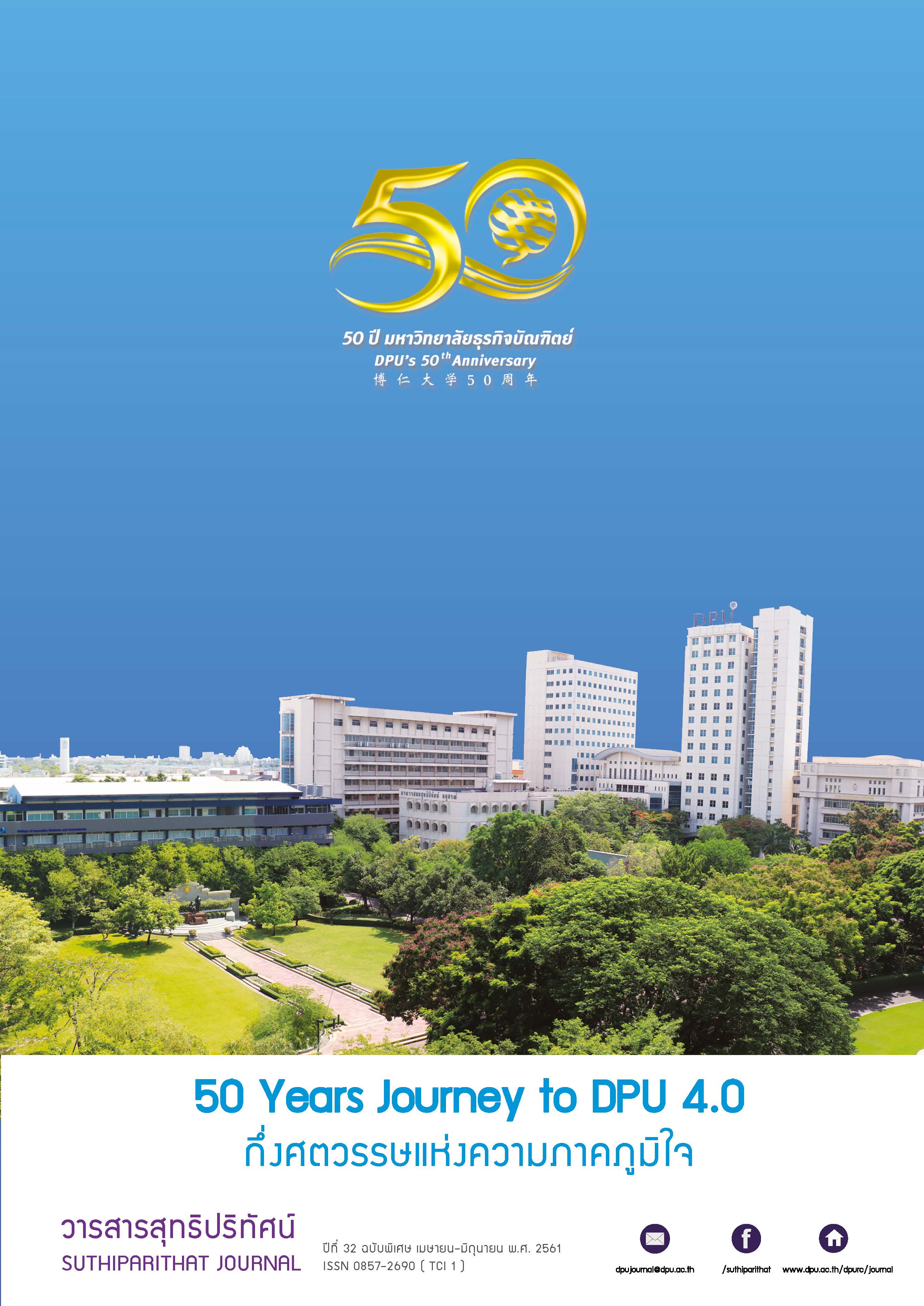รูปแบบการศึกษาที่ส่งผลต่อความสำเร็จของนักศึกษาปริญญาตรีหลักสูตรนานาชาติในประเทศไทย
คำสำคัญ:
ความสำเร็จของนักศึกษานานาชาติ, รูปแบบการศึกษา, สมรรถนะของนักศึกษา, พฤติกรรมการใช้สื่อสังคมออนไลน์บทคัดย่อ
การศึกษาระดับปริญญาตรีในหลักสูตรนานาชาติอาจเป็นหนทางหนึ่งที่ช่วยตอบสนองความต้องการ ด้านความมั่นคงของผู้บริโภค วรรณกรรมที่เกียวข้องกล่าวว่าอาจมีหลายปัจจัยที่มีอิทธิพลต่อความสำเร็จ ด้านการศึกษาของนักศึกษาในหลักสูตรนานาชาติ ในประเทศไทย อาทิสมรรถนะทางด้านวิชาการและด้านภาคปฎิบัติของนักศึกษา วิถีการดำเนินชีวิต พฤติกรรมการใช้สื่อสังคมออนไลน์และการเอาใจใส่ดูแบบ เฉพาะสำหรับนักศึกษานานาชาติ แต่ยังคงมีการศึกษาจำนวนน้อยที่ศึกษาความสัมพันธ์ของปัจจัยเหล่านี้ ในกรอบแนวคิดเดียวกัน หรืออาจเรียกได้ว่า เป็นรูปแบบการศึกษาของตัวแปรที่ส่งผลต่อความสำเร็จ ของนักศึกษานานาชาติในประเทศไทย งานวิจัยนี้ใช้แบบสอบถามในการเก็บข้อมูลจากนักศึกษานานาชาติ จำนวน 303 คน จาก 5 วิทยาลัยและหลักสูตรนานาชาติในกรุงเทพมหานคร ผู้ตอบแบบสอบถามส่วนใหญ่ เป็นเพศชาย ศึกษาอยู่ในชั้นปี 3 ขึ้นไปตามที่คาดไว้ และมาจาก 23 ประเทศโดยส่วนใหญ่เป็นชาวไทย ตามมาด้วยพม่า จีน เวียดนามและอื่นๆ และส่วนใหญ่ทำงานพาร์ทไทม์เฉลี่ย 24 ชั่วโมงต่อสัปดาห์
ผลการทดสอบสมมติฐานพบว่า สมรรถนะด้านภาคปฎิบัติของนักศึกษา อาทิ จากการฝึกงานช่วยเพิ่มความสำเร็จของนักศึกษานานาชาติในประเทศไทยรวมทั้งความสำเร็จของนักศึกษาฯ ยังได้รับอิทธิพล จากพฤติกรรมการใช้สื่อสังคมออนไลน์ นอกจากนี้ยังพบว่าตัวแปรอิสระบางส่วนในรูปแบบการศึกษาที่เสนอ ในงานวิจัยนี้ สามารถนำไปใช้พยากรณ์ความสำเร็จของนักศึกษานานาชาติระดับปริญญาตรีในประเทศไทย ได้ ที่ระดับนัยสำคัญ 0.05 ผลการศึกษานี้สามารถนำไปใช้เป็นแนวทางในการปรับปรุงหลักสูตรการศึกษา ระดับปริญญาตรีให้สามารถสร้างความพึงพอใจต่อนักศึกษานานาชาติ และนายจ้างได้มากขึ้นตลอดจนช่วย ขยายความรู้ให้กับวรรณกรรมในปัจจุบัน
References
Alzahrani, M. (2017).Challenges Facing International Students on Campus.Posted on December 18, 2017. Retrieved from https://www.wes.org/advisor-blog/challenges-facing-international-students-on-campus/
Barkan, T. (2011). SPECIAL REPORT: How are the members of associations using social media today? Retrieved from https://uia.org/sites/dev.uia.be/files/misc_pdfs/roundtable/Social_Media_Use_Survey_ReportIndividuals_2011.pdf.Retrieved on 8 April, 2018.
Bridgestock, L. (2013), Top 5 Challenges of Studying Abroad. Retrieved fromhttps://www.topuniversities.com/blog/top-5-challenges-studying-abroad.
Buasuwan, P. (2018) “Rethinking Thai higher education for Thailand 4.0”, Asian Education and Development Studies, 7(2), 157-173, Retrieved fromhttps://www.emeraldinsight.com/doi/abs/10.1108/AEDS-07-2017-0072.
Canter, N., Link, R. and Mckinley, S. (2014). The best of both worlds: integrating online data into marketing mix models, 2 (1). Retrieved from http://www.nielsen.com/content/dam/corporate/us/en/reports-downloads/2014%20Reports/whats-next-integrating-online-data-into-marketing-mix-models.pdf
Cleesuntorn, A. (2013). Education in Thailand and the challenging issues. Rajabhat Journal of Sciences, Humanities & Social Sciences. 14(2), 1-12, July-December 2013.
ETDA (2013).Thailand Internet User Profile 2013. Electronic Transactions Development Agency (Public Organization). Retrieved from https://www.slideshare.net/etda-thailand/thailandinternet-user-profile-2013-51180739.
DeVellis, R. (2003). Scale development: theory and applications. Theory and Application. Thousand Okas, CA: Sage.
Duggan M., Amanda A., Lampe C. and Ellison N. (2015).Concerns about children, social media and technology use. Retrieved from http://www.pewinternet.org/2015/07/16/concernsabout-children-social-media-and-technology-use/
Five Common Cultural Challenges for International Students (2015). Fly Wire Blog. Retrieved from http://blog.flywire.com/2015/10/14/5-common-cultural-challenges-for-international-students/.
Hull, K. (2014). Using Facebook in the classroom. International Journal Social Media and Interactive Learning Environments, 2(1), 60-69. Retrieved from http://www.inderscience.com/storage/f467511910281123.pdf
Hair, J.F., Black, B., Babin, B., Anderson, R. E., and Tatham, R. L. (2006). Multivariate Data Analysis (6thed.). New Jersey: Pearson Prentice-Hall International Inc.
Joreskog, K. G. and Sorbom, D. (1996). LISREL8: User’s Reference Guide. IL:Scientific Software International Inc.
Kemp, S. (2015). Digital, Social & Mobile Worldwide in 2015. Retrieved from http://wearesocial.net/tag/statistics/.
Kotler, P. (2013). Marketing Management (12thed.). Pearson Prentice Hall: New Jersey.
Kotler, P. & Keller, L (2016). Marketing Management (15th Global ed.). Pearson Prentice Hall: New Jersey.
Kuther, T. (2013). “What employers seek in job applicants: You’ve got the skills they want”, American Psychological Association. Retrieved fromhttp://www.apa.org/ed/precollege/psn/2013/09/job-applicants.aspx.
Leon-Abao de E., Boholano H., Filomena T. and Dayagbil (2015). Engagement To Social Networking: Challenges And Opportunities To Educators, European Scientific Journal (June ed.). 11(16), 173-191. ISSN: 1857 – 7881 (Print) e - ISSN 1857- 7431173.
Liengpradit P., Sinthupinyo, S. and Anuntavoranich, P (2014). Trend of Facebook Usage Behavior and Impacts on the Attitudes amongst Friends in Social Network Circle of Thai Youths: Case Study on College Students. International Journal of Social Sciences, 3(2), 68-80. Retrieved from http://www.iises.net/download/Soubory/soubory-puvodni/pp-68-80_ijossV3N2.pdf.
Manual of Internal Quality Assurance for Higher Education (2014) (คู่มือการประกันคุณภาพการศึกษาภายในระดับอุดมศึกษา พ.ศ.2557) Retrieved from http://www.mua.go.th/users/bhes/QAMUA58/qa%20manual58/manual58.htm
Maslow, A. (1954). Motivation and personality. New York, NY: Harper.
Loanas, E. and Stoica, I. (2014).Social Media and its Impact on Consumers Behavior. International Journal of Economic Practices and Theories, 4 (2), 295-303. Special issue on Marketing and Business Development, e-ISSN 2247–7225.
Nunnally, J., Bernstein, L. (1994). Psychometric theory. New York: McGraw-Hill Higher, INC.
Online social networking questionnaire (2018). SurveyMonkey.com. Retrieved from https://www.surveymonkey.com/r/LMWLMLS.
Plungpongpan, J., Tiangsoongnern, L. and Speece, M. (2016), University social responsibility and brand image. International Journal of Educational management, ID IJEM-10-2014-0136 30(4), 571-591.
Pongpaew, W., Speece, M. Tiangsoongnern, L. (2017).Social Presence and Customer Brand Engagement on Facebook Brand Pages. Journal of Product & Brand Management, 26(3), 262-281. Retrieved from https://doi.org/10.1108/JPBM-08-2015-0956
Suthiwartnarueput T. and Wasanasomsithi P. (2012). Effects of Using Facebook as a Medium for Discussions of English Grammar and Writing of Low-Intermediate EFL Students, Electronic Journal of Foreign Language Teaching, 9(2), 194–214. Retrieved from http://e-flt.nus.edu.sg/v9n22012/suthiwartnarueput.pdf.
Tabachnick, B. G., and Fidell, L. S. (2007). Using Multivariate Statistics (5th ed.). New York: Allyn and Bacon.
Wagner, T. (2009). The Global Achievement Gap from the Center for Global Education at Asia Society. Retrieved from https://asiasociety.org/education/seven-skills-students-need-their-future.
Which universities offer international degree programs? Study in Thailand. org. Retrieved from https://studyinthailand.org/study-abroad-thailand-university/university-college-thailand.html.
Yamane, Taro. (1967). Statistics, An Introductory Analysis (2nded.). New York: Harper and Row.
Downloads
เผยแพร่แล้ว
How to Cite
ฉบับ
บท
License
เนื้อหาและข้อมูลในบทความที่ลงตีพิมพ์ในวารสารสุทธิปริทัศน์ ถือเป็นข้อคิดเห็นและความรับผิดชอบของผู้เขียนบทความโดยตรงซึ่งกองบรรณาธิการวารสาร ไม่จำเป็นต้องเห็นด้วย หรือร่วมรับผิดชอบใดๆ
บทความ ข้อมูล เนื้อหา รูปภาพ ฯลฯ ที่ได้รับการตีพิมพ์ในวารสารสุทธิปริทัศน์ ถือเป็นลิขสิทธิ์ของวารสารสุทธิปริทัศน์หากบุคคลหรือหน่วยงานใดต้องการนำทั้งหมดหรือส่วนหนึ่งส่วนใดไปเผยแพร่ต่อหรือเพื่อกระทำการใด ๆ จะต้องได้รับอนุญาตเป็นลายลักษณ์อักษรจากวารสารสุทธิปริทัศน์ก่อนเท่านั้น






